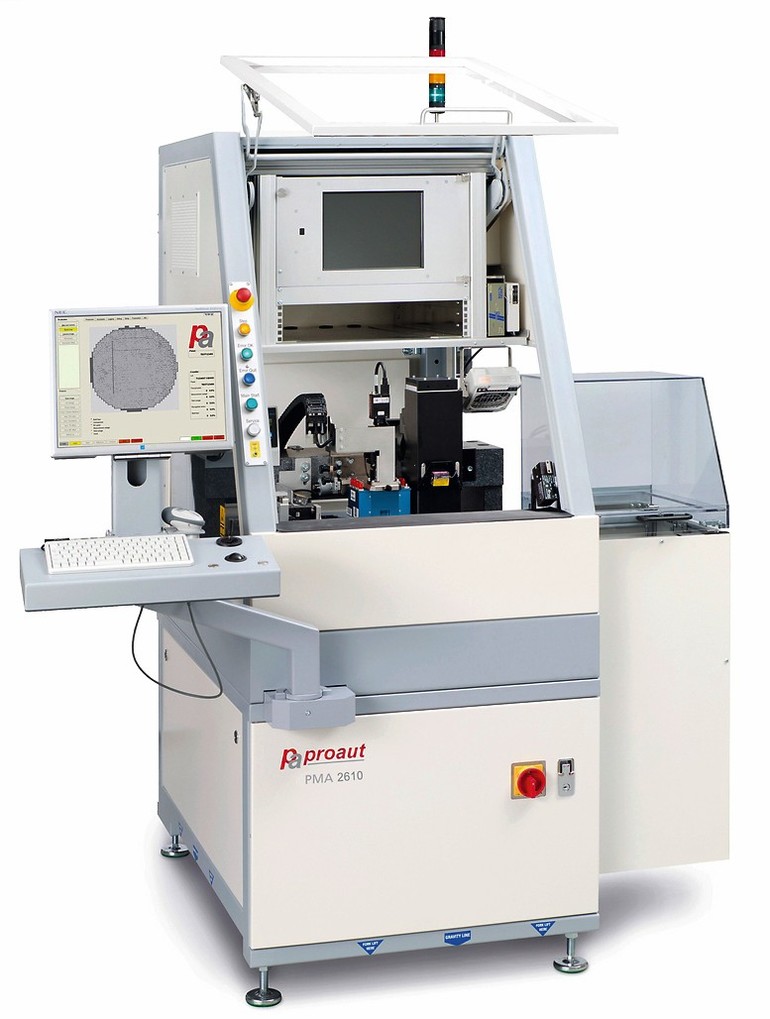When semiconductor test-equipment manufacturer Proaut Technology GmbH began upgrading its PMA wafer-testing series, the goal was to reach a throughput of 40,000 components per hour. The company met its goal using high-efficiency servo drives from Elmo Motion Control.
Recall that semiconductor fabrication relies on sophisticated and expensive equipment to move through complex sequences of time-consuming steps. The microelectronics industry can deliver massive computing power at reasonable pricing because of batch processing — the simultaneous fabrication of hundreds of identical chips on dinner-plate-sized wafers. But the economics of batch processing only hold if the final chips are operational. That means component testing is core to process control, quality assurance, and standards compliance.
“The servo controllers of Elmo Motion Control fully meet all the criteria for the application. They are ruggedly constructed and [fit] the precision measurement machines.” — Mr. Thilo Wicht, CEO of Proaut Technology GmbH
Testing of these semiconductor wafers begins with the patterned wafer to identify any bad chips before expensive packaging. With individual devices measuring just millimeters across, test equipment must be precise, repeatable, and accurate. Test systems must also have the smallest possible footprint — because space in any semiconductor fab is at a premium. What’s more, the testing process must be fast enough to keep pace with the output of microlithography machines.

Faster settling for higher semiconductor throughput
Before measurement can begin with the Proaut Technology PMA machine, the wafer or panel must be installed in the test chamber. Here, a PMA handling system uses a vacuum chuck to remove the component carrier from a magazine located next to the unit … and then place the carrier on a rotary positioning stage. The actual measurement system consists of the stage, a vision system for wafer-position feedback, and optical and electronic measurement tips to collect actual test data.
The stage can execute moves with nanoscale positioning in X, Y, and Z … and positioning in ф to a fraction of a degree. The camera can be positioned along the Z axis for autofocus. During measurements, the system tests sections of the patterned wafer sequentially — taking measurements and then advancing and aligning the wafer to place the next area beneath the measurement tips.
The challenge with quick move-and-settle positioning is that inertia can cause load-move overshoot and oscillation about the commanded position (given the high accelerations and small increments). This can introduce measurement error or slow the measuring process.
Legacy PMA designs were capable of throughput to 30,000 components per hour. But to reach their target throughput of 40,000 components per hour, Proaut engineers needed a way to get higher performance out of existing mechanics. That led them to employ Elmo Gold Whistle servo drives.
Gold Whistle drives feature a function called Gain Scheduling by Profile Status. In gain scheduling, an algorithm lets the system define separate sets of controller parameters— proportional gain (KP), integral gain (KI), higher-order filter links, and so on — to optimize system performance for several distinct application conditions. During operation, the drive can automatically change from one set of controller parameters to another based on the current working point. Filtering helps smooth the effect of changing controller parameters — to ultimately make for faster settling.
Efficient servo drives for more compactness and reliability
Gold Whistle servo drives impart other advantages. The wafer-test application involves highly coordinated motion: The wafer handling axis must coordinate with the positioning stage … and the ф axis of the positioning stage must be tightly coupled with positioning in X, Y, and Z. This type of motion control requires high-speed fieldbus connectivity. Gold Whistle drives are available with either EtherCAT or CANopen. These protocols have ultrafast cycle times and minimal jitter to support best-in-class realtime performance.

Getting this level of coordination also necessitates a centralized control architecture on a master controller to manage the individual axes’ drives. Controller and drives install in a centralized cabinet for simplified wiring and integration. One caveat: Packing six drives into a small enclosed space traps heat that could potentially build enough to degrade performance and cause early electronics failure. Because downtime in the semiconductor industry can cost hundreds of thousands of dollars per hour, Proaut Technology needed to avoid this problem.
Gold Whistle drives operate with a wall-plug efficiency of better than 99% for a minimal heat needing dissipation.
Besides top efficiency, the drives also fit well into the small cabinet space — for a smaller overall machine footprint. “The PMA machines are very compact with a small internal switch cabinet,” says Thiol Wicht, Managing Director of Proaut Technology GmbH. “The miniature size of the Gold Whistle servo drive … is a benefit.”
Gold Whistle drives include onboard intelligence with built-in safety functionality — including safe torque off (STO, SIL-3, IEC 61800-5-2). STO lets the drive stay energized while removing torque from the axis. That makes for quick restarts while ensuring the safety of operators, equipment, and product.
In addition, Elmo Application Studio (EAS) software provides a unified environment for servo drive and motor setup and product or process changes.
With ultra-fast settling times via gain-scheduling technology, Elmo’s Gold Whistle drives let Proaut increase its semiconductor test-machine throughput by 30%. The 99% efficient drives also impart reliability in a compact form factor. For more information, email info-us@elmomc.com or visit www.elmomc.com.







Leave a Reply
You must be logged in to post a comment.